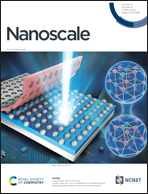Mechanistic insight into bimetallic CoNi-MOF arrays with enhanced performance for supercapacitors†
Abstract
Engineering multicomponent electroactive materials is an effective strategy to improve electrochemical performance by adjusting the atomic and electronic structure. In this work, we directly synthesize oriented bimetallic CoNi-MOF nanosheets on CFP (carbon fiber paper). The CoNi-MOF/CFP shows high specific capacitance, outstanding rate capability and long-term cycling stability compared to a monometallic Ni-MOF or Co-MOF. By adjusting the Co/Ni molar ratio, CoNi23/CFP (Co : Ni = 2 : 3) displays the highest specific capacitance (2033 F g−1 at 1 A g−1). The introduction of Co into the Ni-MOF matrix shortens Co/Ni-centered bond distances, resulting in improved bond strength, facilitating the charge transfer and increasing the electrical conductivity of the CoNi-MOF, which were proved by X-ray absorption fine structure (XAFS) spectroscopy, high angle annular dark field (HAADF) imaging, and electrochemical impedance spectroscopy (EIS). Our study demonstrates the origin of performance improvements and, therefore, may provide a feasible scheme to unlock high-performance MOF electrode materials.



 Please wait while we load your content...
Please wait while we load your content...